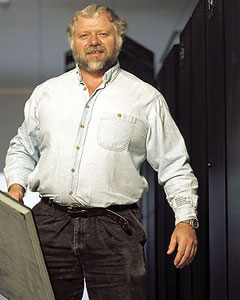News
SDSC Mourns the Loss of Dr. Phil Andrews
Published February 24, 2011

Photo credit: Frank Rogozienski |
Most recently, Dr. Andrews served as project director for the National Institute for Computational Sciences (NICS), with the University of Tennessee and Oak Ridge National Laboratory. In that capacity, he was responsible for overall management and technical leadership of the high-end computing center, which encompasses the National Science Foundation-funded Kraken supercomputer.
"We at SDSC are saddened to hear about the loss of our good friend and colleague," said Michael Norman, SDSC director. "I commend Phil for creating an environment at NICS where the largest computing simulations in the country could be carried out. He believed in high-end, large-scale simulations and he made that a reality."
While at SDSC, Dr. Andrews served as director of high-end computing technologies, and was instrumental in bringing to SDSC several high-end national computing systems.
"Phil was responsible for the successful deployment of some of SDSC's most powerful supercomputers, including the IBM DataStar, in addition to deploying the first production wide-area file system," said Richard Moore, SDSC's deputy director. "He was a powerful advocate for high-performance computing and its significant role in enabling scientific discovery."
"We will all miss Phil's jovial 'Hello'", said Wayne Pfeiffer, an SDSC Distinguished Scientist and a long-time friend and colleague.
Dr. Andrews also played a key role in the launching of the national TeraGrid system, the nation's most powerful collection of high-performance computing resources dedicated to academic research. Later, he became the Principal Investigator for SDSC's support to the TeraGrid Grid Infrastructure Group (GIG), responsible for TeraGrid coordination, overall architecture, planning, software integration, and operations.
Dr. Andrews, a native of the United Kingdom, brought tremendous academic credentials to the challenges he encountered at SDSC, NICS, and the Pittsburgh Supercomputing Center, where he worked before joining SDSC. His degrees in physics, mathematics, and plasma physics came from Cambridge, Purdue, and Princeton universities. He was experienced in artificial intelligence, 3-D software, visualization, archiving, digital libraries, and computational medicine.
During his career, Dr. Andrews authored approximately 40 papers on grid and data-intensive computing, documentation and visualization techniques, theoretical plasma physics and nonlinear dynamics.
"Dr. Andrews also knew something about heavy lifting beyond his intellectual and professional pursuits," said Norman. Earlier this decade, PowerLifting USA magazine ranked him No.2 in the U.S., after hefting 837 pounds at a competition in Las Vegas. His weight-lifting evolved from his college days, when he specialized in the hammer throw.
"Our sympathies go out to Phil's family and friends here and elsewhere," said Norman.
Media Contacts:
Jan Zverina, SDSC Communications
(858) 534-5111 or
jzverina@sdsc.edu
Warren R. Froelich, SDSC Communications
(858) 822-3622 or
froelich@sdsc.edu
Categories
Archive
Related Links
UC San Diego: http://www.ucsd.edu/
NICS: http://www.nics.tennessee.edu/
National Science Foundation: http://www.nsf.gov/
TeraGrid: https://www.teragrid.org/

